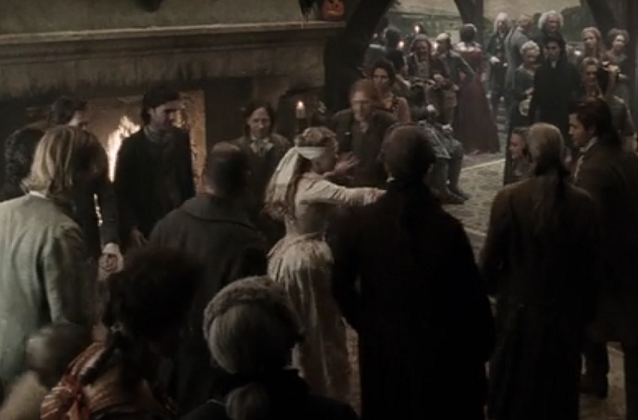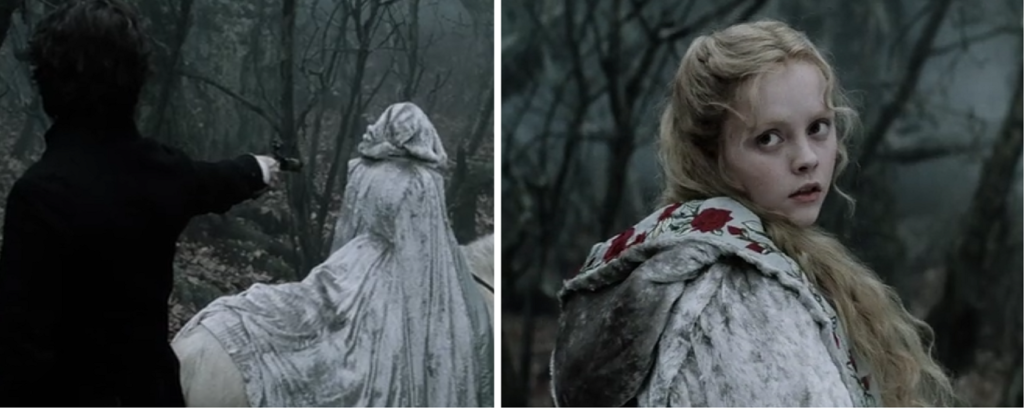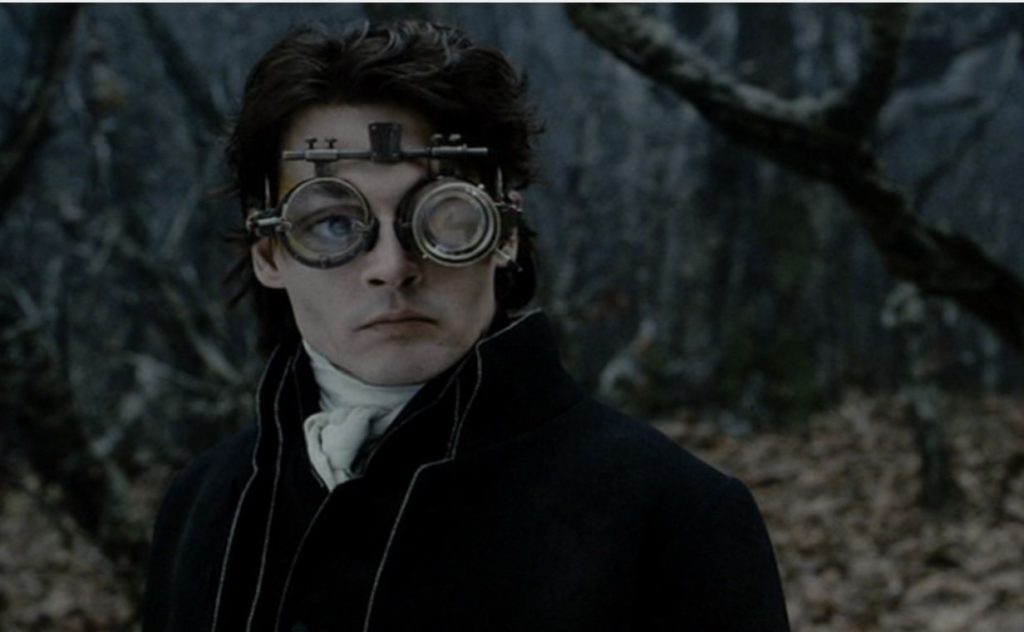 Tim Burton’s 1999 re-imagining of the timeless tale of the Headless Horseman is one of my favorite films. Especially for Halloween. It beguiled audiences with its gorgeous visuals. A bracing bit of grit gave darkly lush sets tactile presence. The screenplay is more mystery than horror, albeit set in a world of witches and demons. The story revolves around a man of science, a non-believer, investigating that world.
Tim Burton’s 1999 re-imagining of the timeless tale of the Headless Horseman is one of my favorite films. Especially for Halloween. It beguiled audiences with its gorgeous visuals. A bracing bit of grit gave darkly lush sets tactile presence. The screenplay is more mystery than horror, albeit set in a world of witches and demons. The story revolves around a man of science, a non-believer, investigating that world.
What do you believe in? …Sense and reason. Cause and consequence.
Sleepy Hollow gave us perhaps the only example in all of cinema of a realistic character portrayal of a scientific investigator tackling the supernatural. It’s done so brilliantly that there are some good lessons in skepticism that bear attention.
The usual investigator character
Usually, a protagonist experiencing the paranormal acts like a fool for the convenience of the screenplay. Even when the supernatural events are happening constantly, they never alert the national media, for example (e.g. Poltergeist, Insidious, It Follows, Oculus). Often, they don’t even try to flee. In Paranormal Activity, the prot realizes there is a ghost with violent tendencies in his house. His plan is then to get cameras and go about his business. You know, the rational thing to do when there’s an unstoppable malevolent entity in your home. Even characters who are scientists act like imbeciles. Agent Scully of the X-Files franchise is an FBI agent and medical doctor. She witnessed numerous things that were clearly beyond the pale. Yet she continued to deny those things exist, she denied her own experiences. It’s as if the writer thought that being a rational investigator means that you don’t believe anything that there isn’t hard evidence for, even things you’ve seen yourself! This makes Scully into the True Believer. She doggedly refuses to let go of her preconceived notions in spite of the evidence, while Mulder updates his knowledge based on new information, regardless of whether it is publishable or not.
Sleepy Hollow is a rare, if not the only, exception to this pattern in a horror setting. In Burton’s movie, Ichabod is a police investigator with a scientific bent.
Sleepy Hollow is all about investigating
The job of the investigator, whether a scientist in a lab or a police detective, is to find the answer to a question. To separate fact from fiction in an unkempt world of deception and misdirection. Burton reinforces this idea frequently in the film. The first time we meet Ichabod Crane, he is urging a superior to see that the apparent cause of a death (drowning in a river) may be confirmed or disconfirmed by lung autopsy. When we first meet Katrina, she is playing a game in which she is blindfolded and searching. She is also spinning, a recurring motif that connotes uncertainty and searching:
“Bad” characters often have a mantle of white or veneer of goodness; “Good” characters are often shrouded in shadow. Other visuals represent illusion, misdirection, and the elusive nature of evidence.
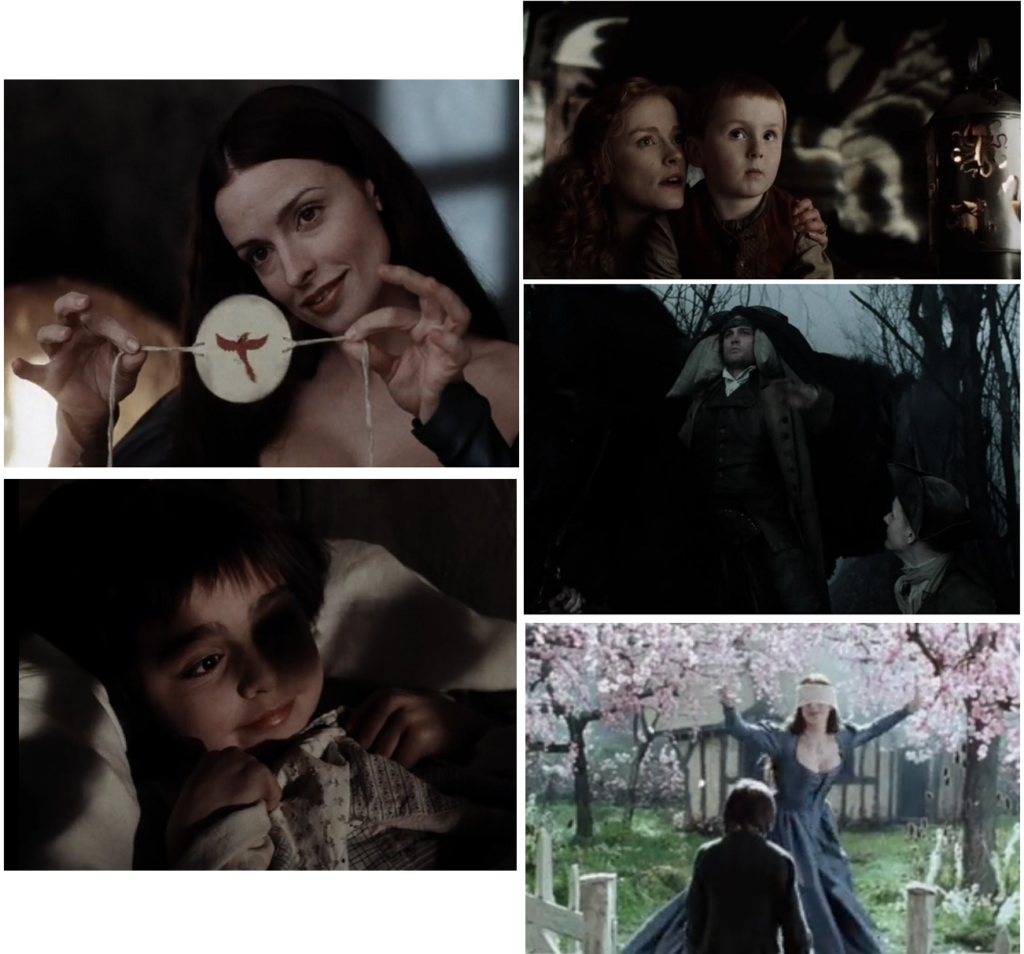
- The importance of empathy and justice
Returning to the first time we meet Ichabod, he is urging others of the value of physical forensic evidence in determining what has happened. He is dismissed and ridiculed. His close-minded colleagues are blinded by their parochial values. Burton uses the blocking of these shots to convey the frustration and powerlessness that Ichabod is feeling: he is literally under them begging to be heard:
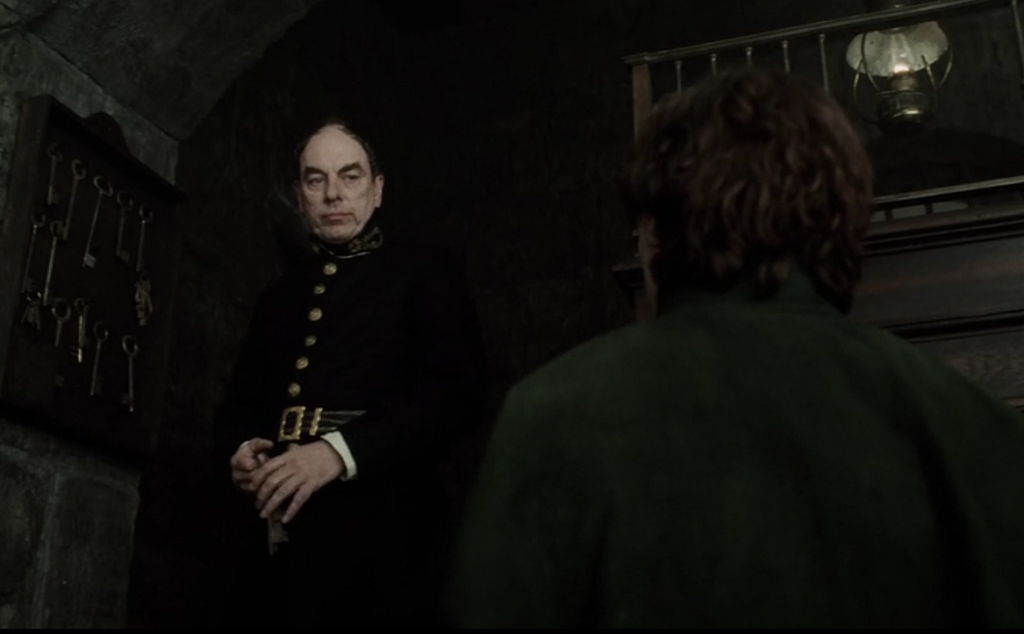
This is important because when Ichabod begins investigating a ghost, he does not believe what the residents tell him. He scoffs initially, but he nonetheless resolves to do his best and takes seriously what the people have to tell him. Indeed, when a town official tells him that he need only “this book”, before plopping down a heavy Bible, he does so immediately. He opens the cover and sees a family tree showing that the two families are closely related, an important clue.
For a skeptical investigator, it is important to take people seriously and treat them with respect, even if you think they’re wrong. Ichabod’s experience being dismissed may have granted him a measure of empathy.
We later learn that his mother was executed as a witch by his Bible-thumping father. Ichabod’s devotion to forensic science and finding the murderer stem from his commitment to justice. Scientific research, skepticism, and criminal investigation must not be sterile or self-serving pursuits, but ultimately public goods that serve the interests of people.
2. Scientific investigation of the paranormal would work just fine, if it existed
In most supernatural thrillers, the supernatural elements can only be addressed in-kind with other supernatural devices. A demon must be exorcised, a curse unmade via magic rituals. Sleepy Hollow, refreshingly, does not take this tack (something it has in common with another great film, Ghostbusters). Ichabod unravels the mystery with ordinary sleuthing, for the most part. Were there real ghosts or other claimed entities, this would remain true in the real world. The movie shows exactly why. It shows how powerful the tools and methods of the investigator are, even when assumptions are violated, and senses are deceived.
“It is but truth; but truth is not always appearance”
Ichabod says this to Katrina, explaining the bird/cage illusion. In other words, our senses can lie to us. Fortunately, we have more to work with than mere eyes and ears etc., and senses can deceive, but not infinitely so. Every illusion may be pierced. Ichabod overcomes the deception and illusion around him by being a careful observer. He leans on the reliable that tools he has: knowledge of psychology, politics, and physical evidence. He considers who has the most to gain from the murders. He discovers a wound was made post-mortem, revealing a conspiracy.
All claims of the paranormal and quackery that I am aware of would also leave physical evidence. Ghosts that can move things can be caught on camera. Ghosts that can bounce photons onto retinas can do the same for cameras. Mythic beasts still need to be part of ecosystems, need to eat, and like all things, leave corpses when they die. Things such as psychics, prophecy, and telepathy should be trivially easy to prove.
3. Bias is not always bad
In Sleepy Hollow, things that commonly mark moral valence are ambiguous. The character Katrina often wears white and light colors and appears kind and sweet. But she also dabbles in witchcraft, leading Ichabod to suspect the worst. The film’s visuals offer clues to the viewer about how this is to be resolved. In this scene, Ichabod does not know who is on the horse; the figure is shrouded in a silvery-grey cloak (note that it is neither black nor white). But a moment later, it is revealed to be Katrina. The cloak has color after all: red flowers— but only on the inside.
The design clues you in that she is not evil, in spite of superficial appearances. In the autumnal, blue-tinted Sleepy world, bright color is rarely seen in the film. Here it recalls the color of the cardinal that Katrina admired as “her favorite” earlier. This references the real bird and also the bird on the thaumatrope that is frequently symbolically linked to Katrina.
I am pinioned by a chain of reasoning!
Throughout the movie, we see that witches may be good or evil. Police, magistrates, and reverends can be corrupt. We often can’t tell right away who or what is good or bad. Biases are like that, too. We tend to think of biases as singularly bad; something to purge. But this is nonsense. A bias is a guiding assumption, and we need them to do anything useful or good in the world. Ichabod begins with naturalistic biases that there are no ghouls, and that witchcraft is generally bad. In his universe, these turned out to be false and lead him astray. But he had many other biases that allowed him to succeeded. He assumed that a killer must have a motive; a purpose. He assumed medical facts applied, even in this setting, leading him to critical clues. He never abandoned his basic forensic mode of inquiry— itself a set of biases.
We need biases our biases. They are only negative when they fail us. Then they must be mended or replaced. To do that, you need something else.
4. You’ll need courage
Ichabod’s life is in danger and after an encounter with the horseman, he was ready to bolt. He relived the murder of his mother in a dream recollection. The injustice of her death restored his resolve to stop the killings in Sleepy Hollow. In reality, we will not face such dangers, of course. But Ichabod has several struggles of a sort we can relate with. In the first act, he risks his career and reputation in his fight for greater justice. Later, he struggles with his own worldview, shaken by new realizations. He loses confidence. He is sometimes unsure whom to trust.
[to Ichabod] You are bewitched by reason. I am beaten down by it! …villainy wears many masks. None so dangerous as the mask of virtue.
Ichabod was ultimately able to change his views in the face of the evidence. Some ideas are so deeply held that we begin to associate them with our identity. Altering those is painful, an ordeal. The inability to reconsider cherished notions has done more harm to humanity than an army of murderous ghosts ever could.

